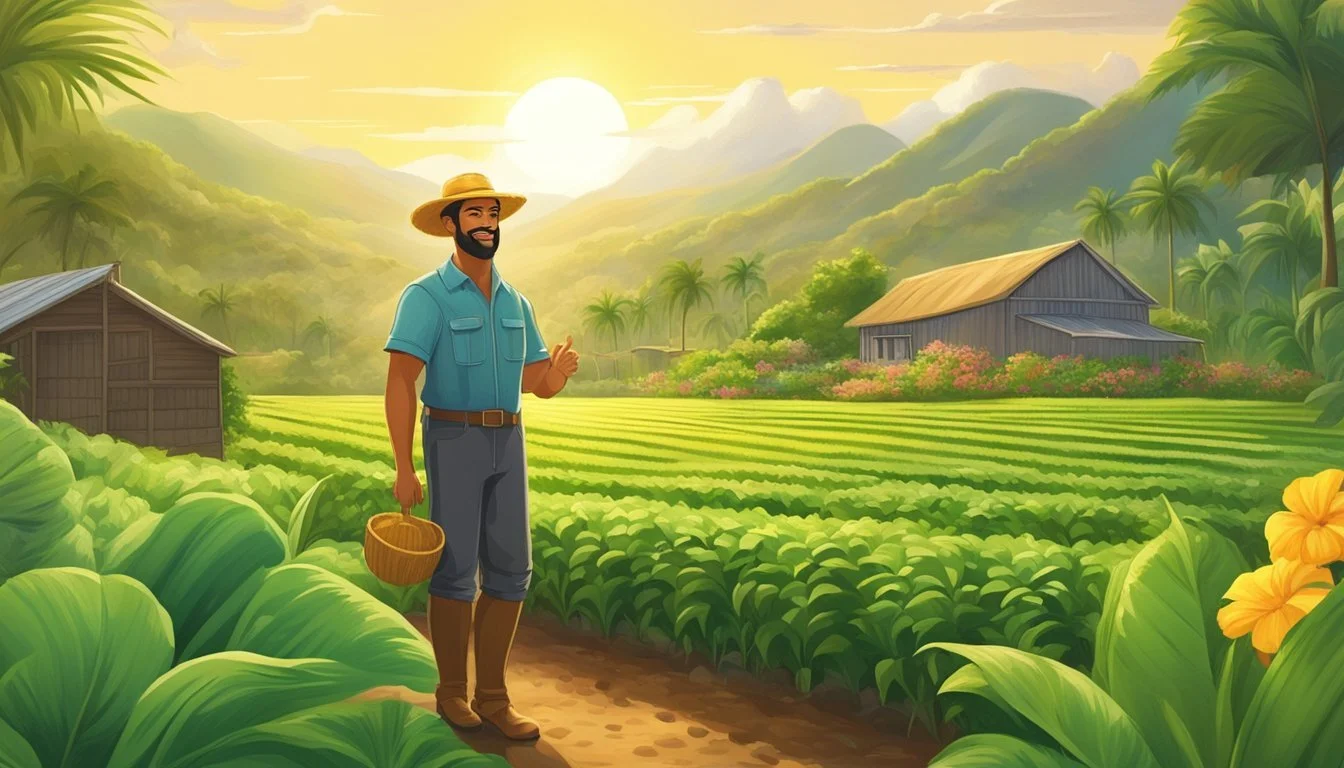Farm Loans in Hawaii
Navigating Financial Aid for Agriculture
This Article is Part of Our Guide on Farm Loans for All 50 U.S. States
Farm loans play a vital role in supporting Hawaii’s agricultural sector, which is a cornerstone of the local economy and a critical source of the state's food supply. It's essential for farmers, especially those starting anew, to have access to capital that allows them to purchase land, invest in equipment, and cover operating expenses. The state has recognized this need and offers various loan programs tailored to assist farmers at different stages of their operations. These loans ensure that farmers who may struggle to secure funds from commercial lenders have the means to sustain and grow their agricultural ventures.
The Hawaii Department of Agriculture administers loan programs aimed at both established farmers and newcomers to the field. With options for Farm Ownership and Improvement loans, as well as Farm Operating loans, these programs are set up to address the broad spectrum of financial needs in the farming community. For example, the New Farmer Loan Program offers a significant aid for those intending to farm full-time, reflecting the state's commitment to fostering the development of its agricultural domain.
In addition to state-sponsored loans, the USDA Farm Service Agency provides support through direct and guaranteed loan programs. These federal loans complement state offerings and provide alternative avenues for Hawaiian farmers to find financial assistance. Programs such as microloans are particularly geared towards small, niche, and beginning farmers, featuring streamlined application processes and reduced requirements, thereby enhancing accessibility for smaller scale operations. Collectively, these resources are designed to empower Hawaii’s farmers with the financial tools needed to thrive in an industry that demands both resilience and adaptability.
Understanding Farm Loans in Hawaii
This section provides a comprehensive overview of the agricultural financing landscape in Hawaii. It outlines the variety of loan types available to farmers, key financial terms, and basics of securing farm-related financing.
Essentials of Farm Financing
When farmers in Hawaii seek financing, they typically require capital for various purposes ranging from land acquisition to operating expenses. Lenders offer loans with different terms and eligibility requirements. Equity and a down payment often form a substantial part of the initial financing structure, with collateral usually being a requisite for securing a loan.
Types of Farm Loans Available
Hawaii offers several loan options for farmers, including:
Farm Ownership and Improvement Loans: This loan allows for purchasing or improving farmland, constructing farm buildings, or liquidating debt tied to these purposes.
Loan Amount: Up to $800,000
Maximum Term: 40 years
Farm Operating Loans and Micro-Loans: These can be used for day-to-day operating expenses.
Micro-Loan Amount: Up to $25,000
Maximum Term: 10 years
Emergency Loans: Released in response to environmental disasters or economic emergencies.
Key Financial Terms
Interest Rate: Fixed at 1% below the prime rate or at 7.5% per annum, whichever is less, with the prime rate set biannually.
Loan Amount: Varies by loan type, with some loans offering up to $800,000 for qualified borrowers.
Collateral: Typically required to secure a loan, may include assets like farmland or agricultural equipment.
Maximum Term: Dictates the lifespan of the loan, affecting the amortization schedule and payment amounts.
Eligibility and Requirements
In Hawaii, securing a farm loan involves meeting specific eligibility criteria, providing detailed documentation, and fulfilling credit and equity requirements. These parameters ensure that the Farm Loan Programs offered by various entities such as the Farm Service Agency (FSA) and the U.S. Department of Agriculture (USDA) are granted to qualified applicants dedicated to agriculture.
Criteria for Farm Loan Eligibility
Eligible applicants for agricultural loans in Hawaii must demonstrate a significant commitment to farming. Criteria include:
Experience: Applicants should have a proven farming ability, often shown by a minimum of three years of farm operation experience, whether on land owned, rented, or leased.
Farm Ownership: Prospective borrowers looking to own or improve a farm must evidence their intent and plan for its use.
Income: A major portion of the applicant's net cash income should be derived from agricultural operations.
Equity Contribution: Loan applicants may need to demonstrate an ability to contribute a certain amount of equity towards the farming enterprise.
Documents and Paperwork
When applying for a farm loan, the required documentation typically comprises:
Loan Application: A completed and detailed application form is essential.
Proof of Experience: Documented evidence of farming experience and capability.
Financial Statements: Applicants must provide records of their financial history and current status, including income statements and balance sheets.
Understanding Credit and Equity Requirements
Understanding the role of credit and equity in the loan process is pivotal for applicants:
Credit History: A sound credit history is crucial, as applicants may be required to show that they were denied credit from two other lenders before applying for a direct loan.
Employment and Income Verification: Applicants must be able to demonstrate sufficient repayment ability and secure enough collateral to fully guarantee the loan, as required by organizations like the Hawaii State Programs under the USDA Farm Service Agency.
Prospective borrowers are advised to consult with the respective agencies or organizations offering farm loans for fact sheets and additional guidance specific to the requirements in Hawaii.
Farm Service Agency (FSA) Loans
The Farm Service Agency (FSA), an agency of the USDA, provides various loan options to support farmers in Hawaii. These loans are crucial for funding farm operation, expansion, or maintenance when traditional commercial credit is unavailable.
Direct Loan Programs
The FSA administers Direct Loan Programs which include both Direct Farm Ownership Loans and Direct Operating Loans.
Direct Farm Ownership Loans allow farmers to purchase land, construct and repair buildings, and make farm improvements. The maximum term for these loans can extend up to 40 years.
Direct Operating Loans provide essential funds to cover the costs associated with running a farm such as purchasing livestock, equipment, seed, and feed.
Guaranteed Loan Program
Under the Guaranteed Loan Program, the FSA backs loans from commercial lenders to family-size farmers and ranchers. This guarantee reduces the risk lenders face, enabling them to provide credit to those who might otherwise be ineligible.
The FSA guarantees up to 95% of the loss of principal and interest on a loan.
Guaranteed loans can be utilized for both farm ownership and operating expenses.
Microloan Programs
The FSA's Microloan Programs are designed to serve the unique financial needs of new, small, niche, and non-traditional farm operations.
Microloans offer a maximum of $50,000, which can be utilized for a variety of farming needs, including startup costs, input costs, tools, and irrigation.
This program simplifies the application process, making it more accessible compared to traditional farm loans.
Farmers and ranchers in Hawaii can apply for these FSA loan programs at their local FSA County Office or check their eligibility using online tools provided by the Farm Service Agency.
Tailored Loans for Diverse Needs
In Hawaii, a range of specialized farm loans is available to cater to varying requirements of the agricultural sector. These loans are designed to support the unique needs of new and established farmers, enabling them to start, expand, maintain operations, or recover from distressing periods.
Loans for New and Beginning Farmers
New and beginning farmers in Hawaii may access agricultural loans with reasonable terms to kick-start their farming ventures. These loans can cover in-ground and above-ground farming, the establishment of greenhouses, hydroponic systems, and more. With loan amounts ranging from $2,500 to $100,000 at a 4% APR, new entrants can take their first steps towards farm ownership and meet the initial operating expenses that come with starting an agricultural business.
Financing for Expansion and Operating Costs
Established farmers and ranchers with a need to expand their operations or cover operating expenses can seek financial assistance through tailored loan programs. Whether it's for marketing expenses, purchasing additional farm land, or development projects, these loans are structured to fit the diverse financial needs of Hawaii's agricultural community. Loan programs administered by the State of Hawaii's Agricultural Loan Division Office aim to facilitate the sustainable growth of the state's agriculture and aquaculture sectors.
Loans for Distressed Borrowers
Farmers experiencing financial hardship have options for support through specially designed loan programs. These aim to assist distressed borrowers in recovering from adverse situations, ensuring the continuity of their farming or ranching operations. By recognizing the cyclical and sometimes unpredictable nature of agriculture, these programs provide a financial lifeline to maintain the stability of farming enterprises during challenging times.
The structured financial products underscore Hawaii's commitment to fostering a resilient and diverse agricultural sector, offering essential support to ensure its continued growth and sustainability.
Application and Approval Process
Navigating the farm loan application and approval process in Hawaii can be a smooth journey with the right information at hand. This critical phase encompasses several steps, each tailored to ensure that applicants meet the loan criteria and that the funds are used effectively for agricultural purposes.
Steps of the Loan Application Process
1. Obtaining the Application: Prospective borrowers begin by sourcing the loan application from any Agricultural Loan Division Office. This task can often be completed online, making the process convenient and efficient.
2. Completing Documentation: Applicants must carefully fill out the application forms and compile all necessary documentation. This typically includes proof of identity, a business plan, evidence of repayment ability, and a detailed description of the intended use of funds.
3. Submission: The completed application and all supporting documents are then submitted to the relevant office. It's advisable for applicants to consult with a loan officer for guidance and to ensure all aspects of the application are in order.
Loan Approval Criteria and Considerations
Assessing Repayment Ability: A pivotal factor in the approval process is evaluating the applicant’s ability to repay the loan. This assessment includes reviewing financial statements, credit history, and projected cash flows.
Guidance by Loan Officers: Throughout the process, loan officers are available to assist applicants. These professionals evaluate the feasibility of the business plan and the applicant's agricultural experience.
Review by the Board: Once the loan officer has made a recommendation, the application often goes to the chairperson of the board of agriculture or a similar authority for final approval.
Post-Approval Procedures
Finalizing Terms: After receiving final approval, applicants are briefed on the terms of the loan, which include the amount, interest rate, and repayment schedule.
Disbursement of Funds: Upon agreeing to the terms, the loan funds are disbursed for the applicant to use as stipulated in the loan agreement.
Regulatory Compliance: Borrowers may be required to adhere to certain regulations and guidelines, which ensures that the loan is utilized for its intended agricultural purpose and maintaining accountability.
Farm Credit and Other Lending Institutions
In Hawaii, agriculture businesses have access to a variety of financing options through Farm Credit services, private lending institutions, and government-aided participation loans. These sources play a crucial role in supporting Hawaii's rural economy.
Farm Credit Services and Associations
Farm Credit provides consistent credit and financial services to the agricultural sector. As of December 31, 2022, in Hawaii, Farm Credit services had extended to 413 customers with a loan volume of $453.6 million, along with patronage dividends amounting to $2.5 million. Such associations are integral to rural development and the financing of agricultural operations.
Private Lenders and Banks
Applicants looking for direct loans in Hawaii's agricultural sector may approach private sector entities such as banks, savings and loan associations, credit unions, and mortgage loan companies. If a farmer is denied credit from two lenders, they become eligible for direct loan programs, indicating the importance of private lenders as initial gateways to government loan support.
Participation Loans from Government Programs
The U.S. Department of Agriculture (USDA) and the Farm Service Agency (FSA) aid Hawaii farmers who do not qualify for conventional loans. The FSA guarantees loans up to a maximum of 95 percent, which are serviced by local agricultural lenders. Participation loans encourage private lenders to extend credit by mitigating risk through government loan guarantees and oversight.
Additional Resources and Support Programs
Hawaii offers a range of resources and support programs designed to assist farmers with financing, risk management, and education. These programs are provided by various entities, including the USDA Farm Service Agency (FSA), and they cater to the unique needs of the agricultural community.
Grants and Funding Opportunities
The USDA Farm Service Agency provides direct and guaranteed loan programs for farmers who face difficulties in accessing private, commercial credit. Qualifying farmers can obtain credit through loan guarantees, with the FSA backing up to 95 percent of the loan.
New Farmer Loans: Maximum loan amounts of $250,000 can be used for Farm Ownership and Improvement Loans or Farm Operating Loans. Micro-Loans for up to $25,000 with a term of up to 10 years are also available specifically for New Farmers in Hawaii.
The Office of Hawaiian Affairs (OHA): Through its Mahi 'Ai Agricultural Loan Program, OHA supports Native Hawaiian farmers by offering loans to start or expand farms.
Insurance and Protection Programs
Farmers can manage their risks through various protection programs:
Crop Insurance: Protects against the loss of their crops due to natural disasters or the loss of revenue due to declines in the prices of agricultural commodities.
Conservation Programs: The Conservation Reserve Program and the Emergency Conservation Program help farmers to conserve natural resources, thereby providing long-term economic stability.
Educational Workshops and Guidance
Education is crucial for sustainable farming practices and business management:
The FSA conducts educational workshops providing guidance on agricultural best practices, financial management, and navigating FSA programs.
County committees composed of local farmers play a significant role in guiding FSA activities in the community, ensuring that there is a conduit for education and support at a grassroots level.








